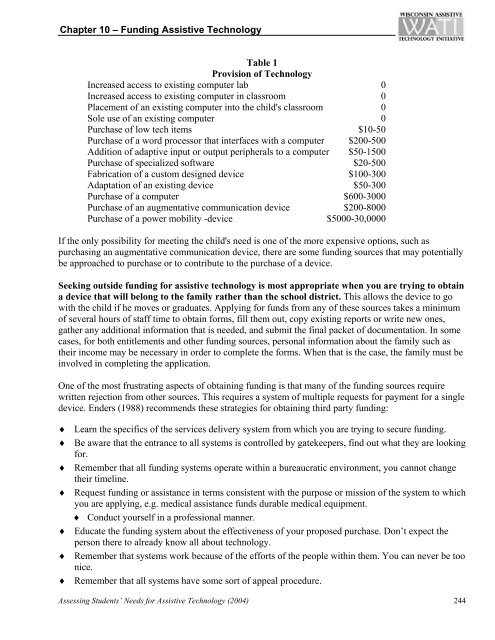Assessing Student's Needs for Assistive Technology (ASNAT)
Assessing Student's Needs for Assistive Technology (ASNAT)
Assessing Student's Needs for Assistive Technology (ASNAT)
Create successful ePaper yourself
Turn your PDF publications into a flip-book with our unique Google optimized e-Paper software.
Chapter 10 – Funding <strong>Assistive</strong> <strong>Technology</strong><br />
Table 1<br />
Provision of <strong>Technology</strong><br />
Increased access to existing computer lab 0<br />
Increased access to existing computer in classroom 0<br />
Placement of an existing computer into the child's classroom 0<br />
Sole use of an existing computer 0<br />
Purchase of low tech items $10-50<br />
Purchase of a word processor that interfaces with a computer $200-500<br />
Addition of adaptive input or output peripherals to a computer $50-1500<br />
Purchase of specialized software $20-500<br />
Fabrication of a custom designed device $100-300<br />
Adaptation of an existing device $50-300<br />
Purchase of a computer $600-3000<br />
Purchase of an augmentative communication device $200-8000<br />
Purchase of a power mobility -device $5000-30,0000<br />
If the only possibility <strong>for</strong> meeting the child's need is one of the more expensive options, such as<br />
purchasing an augmentative communication device, there are some funding sources that may potentially<br />
be approached to purchase or to contribute to the purchase of a device.<br />
Seeking outside funding <strong>for</strong> assistive technology is most appropriate when you are trying to obtain<br />
a device that will belong to the family rather than the school district. This allows the device to go<br />
with the child if he moves or graduates. Applying <strong>for</strong> funds from any of these sources takes a minimum<br />
of several hours of staff time to obtain <strong>for</strong>ms, fill them out, copy existing reports or write new ones,<br />
gather any additional in<strong>for</strong>mation that is needed, and submit the final packet of documentation. In some<br />
cases, <strong>for</strong> both entitlements and other funding sources, personal in<strong>for</strong>mation about the family such as<br />
their income may be necessary in order to complete the <strong>for</strong>ms. When that is the case, the family must be<br />
involved in completing the application.<br />
One of the most frustrating aspects of obtaining funding is that many of the funding sources require<br />
written rejection from other sources. This requires a system of multiple requests <strong>for</strong> payment <strong>for</strong> a single<br />
device. Enders (1988) recommends these strategies <strong>for</strong> obtaining third party funding:<br />
♦ Learn the specifics of the services delivery system from which you are trying to secure funding.<br />
♦ Be aware that the entrance to all systems is controlled by gatekeepers, find out what they are looking<br />
<strong>for</strong>.<br />
♦ Remember that all funding systems operate within a bureaucratic environment, you cannot change<br />
their timeline.<br />
♦ Request funding or assistance in terms consistent with the purpose or mission of the system to which<br />
you are applying, e.g. medical assistance funds durable medical equipment.<br />
♦ Conduct yourself in a professional manner.<br />
♦ Educate the funding system about the effectiveness of your proposed purchase. Don’t expect the<br />
person there to already know all about technology.<br />
♦ Remember that systems work because of the ef<strong>for</strong>ts of the people within them. You can never be too<br />
nice.<br />
♦ Remember that all systems have some sort of appeal procedure.<br />
<strong>Assessing</strong> Students’ <strong>Needs</strong> <strong>for</strong> <strong>Assistive</strong> <strong>Technology</strong> (2004) 244











